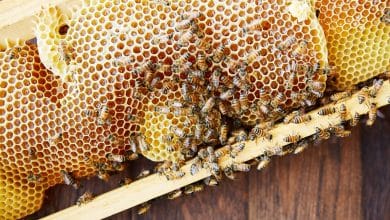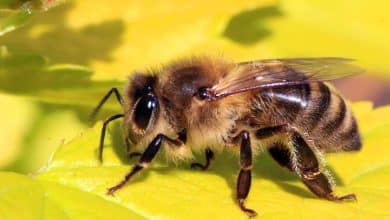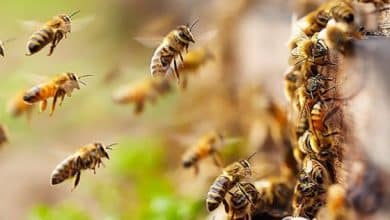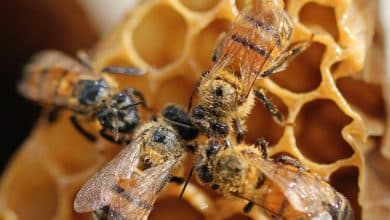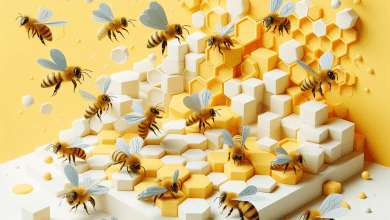italian honey bees

Italian honey bees (Apis mellifera ligustica) have been a popular choice for beekeepers in the United States since they were first imported in 1859. Known for their efficiency in honey production and resistance to varroa mites and brood diseases, Italian honey bees are highly valued for their favorable characteristics.
Beekeeping has become a popular hobby and industry in recent years, with more and more people recognizing the importance of honey bees for pollination and honey production. Italian honey bees have played a significant role in this, as they offer numerous benefits to beekeepers.
The history and origin of Italian honey bees can be traced back to the Ligurian region of Italy, where they were originally bred before being introduced to other parts of the world. Italian bee breeding pioneer Brother Adam described the Italian honey bee in his book “Breeding the Honeybee: From the Commercial and Breeding Point of View”, emphasizing their valuable characteristics.
One of the distinguishing features of Italian honey bees is their physical appearance and coloration. They have a distinct light to dark yellow color with brown bands on their abdomen. This makes them easily recognizable among other bee species. Italian honey bees are also known for their gentle and calm temperament, making them easier to handle and work with for beekeepers.
Italian honey bees‘ efficiency in honey production is another reason why they are highly sought after by beekeepers. They are known to be prolific honey producers, collecting nectar from a wide variety of flowers and producing high-quality honey. This makes them a valuable asset for commercial honey production and also provides a good source of honey for individual beekeepers.
Furthermore, Italian honey bees have shown resilience to various threats, including varroa mites and brood diseases. These pests and diseases can weaken and decimate honey bee colonies, but Italian honey bees have shown a higher tolerance and ability to resist these challenges.
In the following sections, we will delve deeper into the characteristics, management, and comparison of Italian honey bees with other bee species. By understanding their unique traits and care requirements, beekeepers can make informed decisions when choosing Italian honey bees for their apiaries.
A History and Origin of Italian Honey Bees
Italian honey bees, scientifically known as Apis mellifera ligustica, have a rich history and a fascinating origin story. These bees are native to the Apennine Peninsula in Italy and have been present in the region for centuries. They were first introduced to America in 1859, quickly replacing the original black or German bees brought over by the first colonists.
The credit for the introduction of Italian honey bees to the United States goes to an Italian monk by the name of Brother Adam. He played a significant role in breeding and developing the Italian honey bee population in America. Brother Adam described the Italian honey bee in his book “Breeding the Honeybee: From the Commercial and Breeding Point of View,” shedding light on their valuable characteristics and emphasizing their importance in the beekeeping industry.
The Ligurian region of Italy, which includes areas like Genoa and Liguria, served as the breeding ground for Italian honey bees. The region’s favorable climate and abundance of diverse flora provided an ideal environment for bees to thrive. Italian honey bees adapted to this environment and developed unique traits that made them resilient and efficient in honey production.
The introduction of Italian honey bees to America marked a turning point in beekeeping history. Their exceptional qualities, such as gentle temperament, impressive honey production, and resistance to pests and diseases, quickly made them a popular choice among beekeepers. With their vibrant yellow coloration and distinct physical appearance, Italian honey bees became easily recognizable and sought after in the industry. Beekeepers realized the value and potential of Italian honey bees in commercial honey production and their contribution to pollination services.
Today, Italian honey bees continue to be a preferred bee species for beekeepers around the world, with their rich history and origin story playing an important role in their popularity and significance.
B Importance of Italian Honey Bees in Beekeeping
Italian honey bees play a crucial role in the world of beekeeping due to their numerous advantages and valuable characteristics. Their importance can be seen in various aspects of beekeeping, making them a preferred choice for beekeepers around the world.
- High Honey Production: Italian honey bees are known for their exceptional ability to collect and produce large quantities of honey. This makes them highly desirable for commercial honey production, as their high honey yield allows beekeepers to harvest more honey for sale or personal use.
- Gentle Temperament: Italian honey bees are known for their gentle temperament compared to other bee species. They are less likely to sting, making them easier to handle and work with for beekeepers. This aspect is especially important for hobbyist beekeepers or those with limited experience in beekeeping.
- Resistance to Pests and Diseases: Italian honey bees have developed a level of resistance to common bee pests and diseases, such as the Varroa mite. This resistance helps in maintaining the health and well-being of the hive, reducing the need for constant treatments and interventions.
- Excellent Pollination Services: Italian honey bees are efficient pollinators, ensuring the cross-pollination of plants and contributing to the overall health of ecosystems. Their diligent foraging and pollen transfer abilities aid in plant reproduction, resulting in increased crop yields and biodiversity.
Overall, Italian honey bees provide beekeepers with a reliable and productive bee species that contributes to honey production, pollination services, and the sustainability of beekeeping operations. Their important role in the industry is further reinforced by their adaptability, resilience, and valuable traits, making them a popular choice among experienced and novice beekeepers alike.
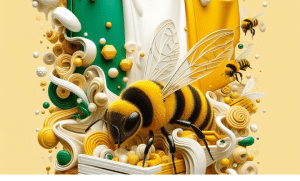
Characteristics of Italian Honey Bees
Italian honey bees, also known as Apis mellifera ligustica, possess several distinctive characteristics that make them highly favored among beekeepers. These characteristics contribute to their success in honey production, ease of management, and overall adaptability. Here are some key characteristics of Italian honey bees:
- Gentleness: Italian honey bees have a reputation for their gentle temperament, making them easier to handle and work with compared to other bee species. Their docile behavior reduces the risk of stinging, making them suitable for novice beekeepers or those with limited experience.
- Prolific Honey Production: Italian honey bees are exceptional honey producers. They have a strong instinct to collect nectar, resulting in higher honey yields compared to other bee species. This makes them a preferred choice for commercial honey production and ensures a steady supply of honey for beekeepers.
- Disease Resistance: Italian honey bees have demonstrated a higher level of resistance to pests and diseases, such as the Varroa mite. This resistance reduces the need for constant intervention and treatments, promoting the overall health and longevity of the hive.
- Foraging Abilities: Italian honey bees are known for their vigorous foraging behavior. They are efficient in collecting pollen and nectar from a wide range of flowers, contributing to pollination and enhancing plant biodiversity.
- Adaptability: Italian honey bees have the ability to adapt to varying climates and environmental conditions. This adaptability allows them to thrive in different regions, making them suitable for beekeepers in various geographical locations.
In conclusion, the characteristics of Italian honey bees, including their gentleness, prolific honey production, disease resistance, foraging abilities, and adaptability, contribute to their importance and popularity in beekeeping. These attributes make them a valuable asset for beekeepers seeking productive and manageable bee colonies.
A Physical Appearance and Coloration of Italian Honey Bees
Italian honey bees, also known as Apis mellifera ligustica, are easily distinguishable by their physical appearance and coloration. These bees have a distinct yellow color, ranging from bright yellow to lemon yellow. The brightness of their color can indicate the age of the bee, with brighter shades typically found in younger bees.
In terms of size, Italian honey bees have a larger abdomen compared to their upper body. This gives them a unique shape, with a pronounced roundness towards the back. Additionally, their abdomens have a spikier end compared to other bee breeds.
One notable physical attribute of Italian honey bees is their tongue length. Their tongues measure around 0.25 inches, which allows them to efficiently extract nectar from flowers. This long tongue enables them to access nectar sources that may be difficult for bees with shorter tongues to reach.
Overall, the physical appearance of Italian honey bees is characterized by their yellow color, larger abdomen, and distinctive tongue length. These traits make them easily recognizable among other bee species. It’s important to note that while Italian honey bees exhibit consistent coloration and physical features, there can be variations within the breed. Beekeepers may observe differences in shades of yellow or slight variations in body proportions among colonies of Italian honey bees.
B Behavior and Temperament of Italian Honey Bees
Italian honey bees, known for their excellent temperament, demonstrate distinct behavior and characteristics that make them a preferred choice for beekeepers. They possess traits that contribute to their overall docile and gentle nature.
Italian honey bees are known for their calm behavior when approached by humans or handled by beekeepers. They are generally less defensive and aggressive compared to other bee species. This makes them easier to manage and less likely to sting, making them a popular choice for beginner beekeepers.
These bees are known for their strong work ethic and productivity. They are highly efficient in terms of foraging and honey production, constantly striving to gather nectar and pollen from flowers. Their hardworking nature contributes to their reputation as prolific honey producers.
Italian honey bees also exhibit strong teamwork and unity within their colonies. They work together harmoniously, displaying a high level of organization and coordination. This trait is essential for efficient nest building, brood rearing, and honey storage.
Furthermore, Italian honey bees have a higher tendency to raise brood in large numbers, ensuring a robust population and increased honey production. This behavior makes them valuable for commercial beekeeping operations and honey production.
It is important to note that although Italian honey bees are generally calm and docile, they can still have their moments of aggression or defensiveness, especially in certain circumstances such as when their hive is threatened or when they perceive a threat to their queen. Beekeepers must always approach their hives with caution and take necessary protective measures to ensure their safety.
Overall, the behavior and temperament of Italian honey bees make them a favorable choice for beekeepers, particularly those seeking gentle and productive bees for honey production and hive management.
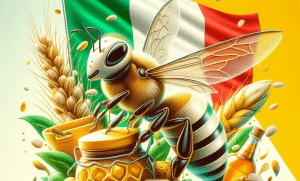
Benefits of Italian Honey Bees
Italian honey bees offer numerous benefits to beekeepers and the overall beekeeping industry. Their unique characteristics and behavior make them highly sought after for honey production and hive management.
- Efficiency in Honey Production: Italian honey bees are renowned for their exceptional work ethic and productivity. They are efficient foragers, constantly collecting nectar and pollen from flowers, resulting in a high honey yield. Their industrious nature makes them valuable for commercial beekeeping operations, as they can produce large quantities of honey.
- Resistance to Varroa Mites and Brood Diseases: Italian honey bees exhibit a higher level of resistance to common pests and diseases, including Varroa mites, which can devastate bee colonies. Their tolerance to these threats reduces the need for extensive chemical treatments, promoting sustainable and natural beekeeping practices.
- Gentle Temperament: Italian honey bees are known for their calm and docile demeanor. They are less likely to display aggressive behavior compared to other bee species, making them easier to manage and less likely to sting. Their gentle temperament is particularly beneficial for novice beekeepers and those working in close proximity to their hives.
- Strong Colony Growth: Italian honey bees have a natural tendency to build large and robust colonies with a high brood production rate. This allows for a larger workforce, resulting in increased honey production and overall hive efficiency.
- Adaptability: Italian honey bees have adapted well to different climates and environmental conditions. They are able to thrive in various regions and climates, making them a versatile choice for beekeepers worldwide.
- Pollination Benefits: Italian honey bees are excellent pollinators, contributing to the pollination of various crop plants and wildflowers. This vital role in plant reproduction enhances agricultural productivity and biodiversity.
In conclusion, Italian honey bees offer a range of benefits to beekeepers, including high honey production, resistance to pests and diseases, gentle temperament, strong colony growth, adaptability, and valuable pollination services. These characteristics make them a popular choice for both hobbyist and commercial beekeepers seeking productive and manageable honey bee colonies.
A Efficiency in Honey Production
Italian honey bees are renowned for their exceptional efficiency in honey production, making them highly sought after by beekeepers. Their diligent work ethic and productivity make them valuable for both commercial and hobbyist beekeeping operations.
Italian honey bees are strong foragers, constantly collecting nectar and pollen from flowers. Their exceptional foraging skills result in a high honey yield, making them ideal for honey production. These bees have a natural propensity for finding and utilizing floral resources efficiently, maximizing the honey production potential of a hive.
Moreover, Italian honey bees have a high brood production rate, leading to strong colony growth. This means they have a larger workforce available for collecting nectar and converting it into honey. With a thriving colony, Italian honey bees can produce significant quantities of honey, making them a favorite choice for beekeepers aiming for high honey yields.
Their adaptability and versatility also contribute to their efficiency in honey production. Italian honey bees have successfully adapted to different climates and environmental conditions, allowing beekeepers to maintain colonies in various regions. This adaptability ensures that Italian honey bees can continue their foraging activities and honey production, regardless of the environment they are in.
In conclusion, Italian honey bees excel in honey production due to their exceptional foraging skills, high brood production rate, adaptability, and versatile nature. Beekeepers can rely on these diligent and efficient bees to produce ample amounts of honey, making them a top choice for honey production purposes.
B Resistance to Varroa Mites and Brood Diseases
Italian honey bees exhibit a commendable resistance to Varroa mites, which are one of the most significant threats to honey bee colonies worldwide. These parasitic mites attach themselves to the bees and feed on their hemolymph, weakening and ultimately killing the infested bees. However, Italian honey bees have demonstrated a certain level of tolerance and resistance to Varroa mite infestations.
Through careful breeding programs and selection, beekeepers have been able to develop Italian honey bee strains that exhibit better resistance to Varroa mites. These resistant strains show behaviors such as grooming and hygienic behavior, which help in reducing mite populations within the hive. Italian honey bee colonies with higher levels of Varroa mite resistance are less susceptible to mite-related issues, ensuring the overall health and survival of the colony.
In addition to their resistance to Varroa mites, Italian honey bees also possess an inherent ability to combat brood diseases. They can detect and remove infected brood from the colony, preventing the spread of diseases. This hygienic behavior is crucial in maintaining the overall health of the hive.
By selecting for these traits of resistance and disease detection, beekeepers can effectively manage Varroa mites and prevent the outbreak and spread of brood diseases within Italian honey bee colonies. This resistance contributes to the sustainability and productivity of honey bee colonies, making Italian honey bees even more valuable in beekeeping operations.
It is important for beekeepers to continue breeding and selecting for Varroa mite resistance and disease detection traits in Italian honey bees to ensure the long-term health and survival of honey bee populations. This ongoing effort will help mitigate the damaging effects of mites and diseases and maintain the productivity of honey bee colonies.
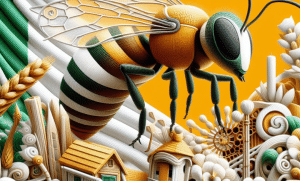
Management and Care of Italian Honey Bees
To ensure the health and productivity of Italian honey bee colonies, proper management and care practices are essential. Here are some important aspects to consider when managing Italian honey bees:
- Hive Setup and Maintenance: Italian honey bees require suitable hive setups to thrive. This includes providing adequate space for brood and honey storage, ventilation, and protection from extreme weather conditions. Regular hive inspections should be conducted to check for disease, pests, and overall hive health.
- Feeding and Health Management: Italian honey bees may require supplemental feeding during periods of nectar scarcity or in preparation for winter. This can be done with sugar syrup or pollen substitutes. Additionally, proactive health management is crucial to prevent and control diseases. Regular monitoring and treatment for common issues such as Varroa mites and brood diseases are necessary.
- Queen Maintenance: The queen is the heart of the colony, responsible for egg-laying and colony growth. Regular inspection and replacement of the queen may be necessary to maintain a strong and productive colony. Beekeepers can consider requeening every one to two years to ensure a healthy and vigorous population.
- Swarm Prevention: Italian honey bees have a tendency to swarm, where a portion of the colony leaves with the old queen to establish a new hive. Swarm prevention measures, such as providing enough space for the colony to expand, regular colony inspections, and timely swarm management techniques, are necessary to avoid losing bees and maintaining colony strength.
- Environmental Considerations: Italian honey bees thrive in a reliable and warm climate. It is important to select suitable apiary locations with access to abundant forage and minimal pesticide exposure. Providing a diverse range of flowering plants in the vicinity of the hives can also benefit the bees by ensuring a consistent food source.
By implementing these management and care practices, beekeepers can ensure the long-term health and productivity of Italian honey bee colonies, maximizing honey production and contributing to the sustainability of the beekeeping operation.
A Hive Setup and Maintenance for Italian Honey Bees
When setting up a hive for Italian honey bees, it is important to provide the right conditions for their well-being and productivity. Italian honey bees require adequate space for brood and honey storage, proper ventilation, and protection from extreme weather conditions. Here are some key aspects to consider in the hive setup and maintenance for Italian honey bees:
- Hive Size: Italian honey bees are known for their rapid buildup in spring, so it’s essential to provide enough space for their expansion. A standard Langstroth hive with deep brood boxes is commonly used. It is recommended to start with two deep brood boxes to accommodate the growing population.
- Frames and Foundation: Italian honey bees prefer wax foundation with small cell size (4.9mm) as it closely matches their natural comb size. This promotes brood rearing and comb building efficiency. Beeswax foundation should be installed in the frames, ensuring they are properly aligned.
- Ventilation: Adequate ventilation is crucial to prevent moisture buildup in the hive, which can lead to mold or fungal growth. Hive ventilation can be enhanced by providing screened bottom boards, upper entrance holes, and proper placement of queen excluders and honey supers.
- Hive Inspections: Regular hive inspections are necessary to monitor the health and activity of Italian honey bees. Inspect for signs of disease, pests (like Varroa mites), and overall hive condition. Bees should be calm and abundant in numbers, with brood in various stages of development.
- Hive Placement: Choose a suitable location for hive placement, away from extreme weather conditions and direct sunlight. The hive should have access to abundant forage and minimal exposure to pesticides or other chemical sources.
By following these guidelines, beekeepers can set up and maintain hives that provide the ideal environment for Italian honey bees to thrive and fulfill their role as efficient honey producers.
B Feeding and Health Management of Italian Honey Bees
To ensure the health and productivity of Italian honey bees, proper feeding and health management techniques are crucial. Italian honey bees require a balanced diet to meet their nutritional needs, especially during periods of dearth when natural food sources may be limited. Beekeepers can provide supplementary food in the form of artificial pollen substitutes or supplements to help sustain the colony during these times. Research has shown that feeding Italian honey bee colonies with artificial diets can support brood rearing activity and promote honey productivity.
In addition to feeding, health management plays a vital role in maintaining the well-being of Italian honey bees. Regular hive inspections are necessary to monitor the health of the colony and detect any signs of disease or pest infestations, such as Varroa mites. Beekeepers should also be aware of the impact of pesticides on Italian honey bees and take precautions to minimize exposure.
To promote a healthy hive environment, beekeepers should implement proper sanitation practices, including cleaning and disinfecting hive equipment. This helps prevent the spread of diseases and pests. Providing adequate ventilation in the hive is also important to prevent moisture buildup, which can lead to mold or fungal growth.
By implementing a comprehensive feeding and health management plan, beekeepers can ensure the long-term success and vitality of Italian honey bee colonies. Regular monitoring and proactive care are essential to maintaining the health and productivity of these valuable pollinators.
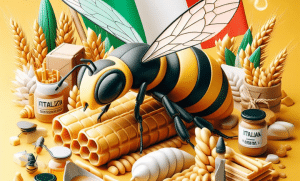
Italian Honey Bees vs. Other Bee Species
Italian honey bees, also known as Apis mellifera ligustica, are a popular choice among beekeepers for their outstanding characteristics and benefits. When compared to other bee species, Italian honey bees offer distinct advantages that make them a preferred choice.
One of the key advantages of Italian honey bees is their exceptional productivity in honey production. They have a strong work ethic and are known for their ability to produce large quantities of honey. This makes them highly desirable for commercial beekeepers and honey production operations.
Another advantage of Italian honey bees is their mild temperament. Unlike more aggressive species such as Russian or Africanized bees, Italians are known for their docile nature. This makes them easier to handle and reduces the risk of stings, especially for beekeepers with less experience.
Italian honey bees also have a higher resistance to Varroa mites and brood diseases, compared to other bee species. Varroa mites are a common parasite that can weaken and destroy honey bee colonies. Italian honey bees have shown better resilience against these pests, making them more resilient and easier to manage.
Additionally, Italian honey bees have demonstrated better survival rates during winter months, compared to more docile species. This is due to their ability to maintain larger population sizes and efficiently use their honey stores for sustenance during colder periods.
While other bee species like Carniolan bees also have their own unique qualities, Italian honey bees are often favored for their balance of productivity, temperament, and resilience. Whether for commercial or hobbyist beekeeping, Italian honey bees continue to be a top choice among beekeepers for their exceptional characteristics and benefits to honey production.
A Comparison with Carniolan Bees
When it comes to choosing between Italian honey bees and Carniolan honey bees, beekeepers may find themselves weighing the pros and cons of each species. While both Italian and Carniolan bees have their own unique qualities, there are several key differences to consider.
One of the main differences between Italian and Carniolan bees is their behavior and temperament. Italian bees are known for their gentle nature and low aggression, making them easier to handle for beekeepers, especially those with less experience. On the other hand, Carniolan bees are known for their calm demeanor and tendency to swarm less frequently, which can be beneficial for beekeepers who want to minimize the risk of swarming.
In terms of honey production, Italian bees have a slight advantage over Carniolan bees. Italian bees are known for their exceptional productivity and ability to produce large quantities of honey. They have a strong work ethic and are highly efficient in collecting nectar and converting it into honey. While Carniolan bees are also productive honey producers, they tend to be slightly less prolific in comparison.
Another important factor to consider is winter survival. Italian bees have shown better resilience and survival rates during the colder months, thanks to their ability to maintain larger population sizes and effectively utilize their honey stores for sustenance. Conversely, Carniolan bees have a reputation for being winter-hardy and can fare well in colder climates.
Overall, the choice between Italian and Carniolan bees ultimately depends on the specific preferences and goals of the beekeeper. Italian bees excel in honey production and their gentle nature makes them easier to manage, while Carniolan bees are known for their calm temperament and winter hardiness. Considering these factors, beekeepers should carefully evaluate their own needs and decide which species aligns best with their beekeeping objectives.
B Comparison with Africanized Bees
Africanized honey bees, also known as African bees or AHBs, are a subspecies of honey bees that originated from hybridization between European honey bees and African honey bees in Brazil. Compared to Italian honey bees, Africanized bees have several distinct characteristics.
One significant difference is their defensive behavior. Africanized bees are highly defensive and tend to react aggressively when they perceive a threat. This defensive behavior is a result of their African honey bee genetics, which were naturally selected for in their native environment. In contrast, Italian bees are known for their gentle nature and low aggression.
Another difference is their tendency to swarm more frequently. Africanized bees have a higher propensity for swarming as compared to Italian bees. Swarming occurs when a large group of bees, including the old queen, leaves the hive to establish a new colony. While swarming is a natural reproductive process for bees, it can be challenging for beekeepers to manage.
In terms of honey production, Africanized bees are generally less productive compared to Italian bees. Their primary focus is on colony survival and reproduction rather than maximizing honey production. Italian bees, on the other hand, have a strong work ethic and are highly efficient in collecting nectar and converting it into honey.
Furthermore, Africanized bees have shown better resistance to pests and diseases, including Varroa mites, which are known to be a major threat to honey bee colonies. This resistance is attributed to their African honey bee genetics, which have evolved in response to a range of challenges in their native habitat.
Overall, beekeepers should consider their own preferences and objectives when choosing between Italian honey bees and Africanized bees. Italian bees are known for their gentle nature and honey production, while Africanized bees offer benefits such as increased defense against pests and diseases. Understanding these differences can help beekeepers make an informed decision that aligns with their specific needs.

Conclusion italian honey bees
In conclusion, Italian honey bees are a highly valued and popular choice for beekeepers due to their numerous advantages and beneficial characteristics. These honey bees have a rich history and origin, stemming from their European heritage and selective breeding for desirable traits.
Italian honey bees exhibit a gentle nature and mild temperament, making them easy to work with and suitable for beekeepers of all experience levels. They are efficient in honey production, creating strong colonies that grow rapidly and produce a large supply of delicious honey. Additionally, Italian bees demonstrate better resistance to pests and diseases, such as Varroa mites and brood diseases, enhancing their overall resilience and survival rate.
When it comes to management and care, Italian honey bees require proper hive setup and regular maintenance. Beekeepers should also ensure their nutritional needs and health management are met to support optimal colony development and productivity.
While they have many advantages, it is important to note that Italian honey bees may not fare as well as more aggressive species during winter months. However, their cooperative nature and ease of handling make them an attractive option for beekeepers seeking a balanced and manageable bee species.
In summary, Italian honey bees offer a combination of gentle temperament, efficient honey production, and disease resistance, making them an ideal choice for beekeepers looking for productive and manageable colonies. By following proper management techniques and providing adequate care, beekeepers can enjoy the rewards of working with these amazing insects while supporting their health and productivity.
A Advantages and Disadvantages of Keeping Italian Honey Bees
Italian honey bees offer several advantages for beekeepers. Firstly, they are known for their gentle temperament and mild behavior, making them easier to work with compared to more aggressive species like Russian or Africanized bees. This makes Italian honey bees a suitable choice for beekeepers of all experience levels, especially for beginners who may be less familiar with beekeeping techniques.
In terms of honey production, Italian honey bees are highly efficient. They create strong and rapidly growing colonies that produce a large supply of honey. This abundance of honey can be advantageous for beekeepers looking to harvest and sell honey or use it for personal consumption.
Italian honey bees also demonstrate better resistance to common pests and diseases, such as Varroa mites and brood diseases. This resistance contributes to their overall resilience and survival rate, which is beneficial for colony health and longevity.
However, it is important to note that Italian honey bees may not fare as well as more aggressive species during winter months. Their less aggressive nature and lower ability to cluster tightly may result in increased risk of winter losses. Beekeepers should take proper measures, such as ensuring sufficient food stores and protecting the hive from extreme weather conditions, to support their Italian honey bee colonies during cold months.
In conclusion, the advantages of keeping Italian honey bees include their gentle temperament, efficient honey production, and resistance to pests and diseases. However, beekeepers should consider the potential challenge of winter survival when managing Italian honey bee colonies. By providing proper care and management techniques, beekeepers can enjoy the benefits of working with these productive and manageable honey bees.
B Tips for Successful Beekeeping with Italian Honey Bees
When it comes to successful beekeeping with Italian honey bees, there are a few key tips to keep in mind. These tips will help you ensure the health and productivity of your Italian honey bee colonies:
- Provide a Suitable Environment: Italian honey bees thrive in temperate climates, so make sure to provide them with a suitable habitat. Ensure that they have access to clean water and provide a well-ventilated hive with adequate shade and protection from extreme weather conditions.
- Regular Inspections: Regular hive inspections are crucial for monitoring the health of your Italian honey bee colonies. Check for signs of disease, pests, or any other issues. Early detection and intervention can prevent the spread of diseases or infestations.
- Proper Feeding: Italian honey bees require a consistent food supply, especially during times of nectar dearth. Provide them with ample food stores by feeding them sugar syrup or pollen substitute when necessary. This will help them maintain their strength and productivity.
- Swarm Prevention: Italian honey bees are known to be prone to swarming. To prevent swarming, make sure to provide enough space for the colony to expand within the hive. Regularly check for signs of overcrowding and make splits if necessary.
- Pest and Disease Management: While Italian honey bees have good resistance to certain pests and diseases, it’s still important to proactively manage and monitor for issues. Implement integrated pest management techniques and follow recommended best practices for disease control.
- Education and Research: Stay updated on the latest research and best practices in beekeeping. Attend workshops, join local beekeeping associations, and network with experienced beekeepers to gain valuable knowledge and insights.
By following these tips, you can enjoy a successful beekeeping experience with Italian honey bees and reap the rewards of their gentle nature and efficient honey production.
As we come to the close of our fascinating journey into the world of Italian honey bees, it’s evident that the Apis mellifera ligustica species is proficient and admirable in its contributions to both nature and agriculture. The traits that these bees exhibit are a testament to the delicate art of bee breeding and the ecological significance of their role as pollinators. Thank you for buzzing along with us as we delved into the traits that make the Italian honey bee a model of apian excellence.
Now, we’d love to keep the conversation going and hear from you! Share with us your experiences, questions, or the insights you have regarding Italian honey bees. Whether you’re a seasoned apiarist, a beginner in beekeeping, or simply an enthusiast of these hardworking insects, your thoughts are valuable. Join the hive of discussion below, and let’s continue to learn from each other!



